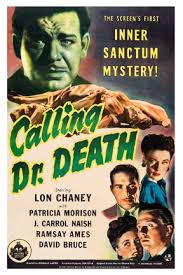
Dr. Mark Steele (Lon Chaney Jr.) is a neurologist who sometimes uses hypnosis in helping patients overcome certain muscle conditions. He has a thriving practice but his home life is far from ideal. His wife Maria (Ramsay Ames) has been cheating on him. She married him for his money and his position in society. Two things she will never give up. When he confronts her she refuses to divorce him.
At one point, Maria goes away for the weekend. Mark is furious when he finds out she has gone. He runs from the house, gets in his car and drives. The next thing he remembers is being awakened in the office by his nurse Stella Madden (Patricia Morison). Not too long afte,r two police detectives show up at the office to question him. They tell him that his wife was found dead at their lodge sometime over the weekend. Mark is taken to the lodge to identify her body.
Police Inspector Gregg (J. Carrol Naish) is waiting for him at the lodge. Mark sees that Maria had been bludgeoned and acid poured on her face. It appears to be a crime of passion. On the rug he finds a small button. He picks it up and unthinkingly puts it in his pocket. His mind is racing trying to figure out what he did over the weekend but he still remembers nothing. Later he finds that the button belongs to the sleeve of his suit jacket.
Gregg calls and tells Mark that they arrested the man who murdered his wife. His name is Robert Duval (David Bruce) and he has been having an affair with Maria. Duval swears that he is innocent. Mark believes him because he is beginning to think that perhaps he was the killer but just doesn’t remember it. Inspector Gregg also suspects Mark of being the real killer. Duval is convicted and sentenced to death. Mark, still believing that he may have murdered his own wife decides that they only way to either clear or convict himself is to put himself under self hypnosis.
“Calling Dr. Death” was released in 1943 and was directed by Reginald Le Borg. It is a horror mystery and a film noir. This is the first in a series of six movies done by Universal Pictures that were styled after the old Inner Sanctum radio program.
The radio show ran from 1941 to 1952. It was based on Simon & Schuster mystery novels that were under the Inner Sanctum Mystery imprint. In 1943 Universal purchased screen rights to the Simon & Schuster series.
The movie was actually not bad. It’s short and moves at a decent pace. The mystery is kept pretty well for most of the film. It’s not a complicated plot but the writing was fine and the acting good. It also has some wonderful noir flavor to it. Some found the voiceover distracting but noir films often have voiceovers so it added some extra atmosphere to the movie. Despite the fact that the plot is basic there are a few added twists and turns along the way.
“Calling Dr. Death” incorporates the use of "stream of consciousness" voiceovers that Chaney speaks. Adding a lot of speech in the voiceover simplifies the script. This was at Chaney’s request. Scriptwriter Edward Dein said that Chaney wanted the dialogue on the soundtrack because a lot of the words were too technical for him to say. Director Reginald LeBorg relates that the producer Ben Pivar didn’t understand the technical medical jargon either. According to LeBorg Pivar was "very, very crude, not very intelligent, and he couldn't read very well".
All of the films featured Lon Chaney Jr. Chaney had been looking for something different than the usual monster movies he was typecast in. The idea was to make two Inner Sanctum mystery films a year with Chaney. Only six films were actually made: “Calling Dr. Death” 1943, “Weird Woman” 1944, “Dead Man’s Eyes” 1944, “The Frozen Ghost” 1945, “Strange Confession” 1945 and “Pillow of Death” 1945.

